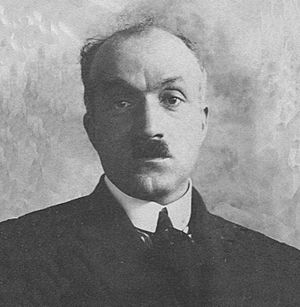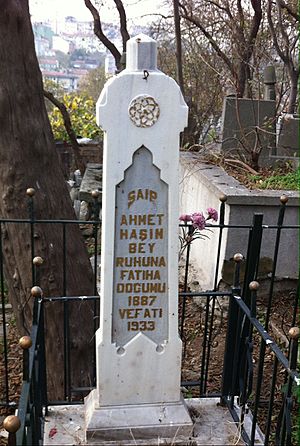Ahmet Haşim facts for kids
Quick facts for kids
Ahmet Haşim
|
|
|---|---|
 |
|
| Nationality | Turkish |
| Occupation | Poet |
Ahmet Haşim (also known as Ahmed Hâşim; born around 1884 – died June 4, 1933) was a very important Turkish poet. He lived and wrote in the early 20th century.
Contents
About Ahmet Haşim
His Life Journey
Ahmed Hâşim was likely born in Baghdad around the year 1884. His father was a governor in a part of the Ottoman Empire called Fizan. When his mother passed away around 1893, Ahmed moved to Istanbul with his father.
He finished school at Mekteb-i Sultanî (now Galatasaray High School) in 1906. After graduating, he started working for the state tobacco company. He also studied law at Istanbul University. From 1908 to 1910, Hâşim taught French in İzmir. He also worked for the government office that managed public debts.
During World War I, he was called to serve in the army. He spent most of his time in Anatolia. After the war, he went back to Istanbul. There, he worked at the Ottoman Bank. When the Republic of Turkey was founded, Hâşim became a teacher. He taught art at the Academy of Fine Arts. He also taught French at Istanbul University. For many years, he wrote articles for newspapers like Akşam and İkdam.
Ahmed Hâşim passed away on June 4, 1933. He was buried at the Eyüp Cemetery in Istanbul.
His Poetic Works
Early Poems and Movements
Ahmet Hâşim's first poems appeared in a magazine called Mecmua-i Edebiye. This was between 1900 and 1912. During this time, he was part of a group called Fecr-i Âtî. This name means "Dawn of the Future." Later, he published poems with other writers in a magazine named Dergâh.
Around 1921, he released his first poetry book, Göl Saatleri. This means "Hours of the Lake." His second book of poems, Piyâle, came out in 1926. Piyâle means "The Wine Cup."
Hâşim's early poems were influenced by poets like Tevfik Fikret and Cenab Şahâbeddin. These poets were part of the "New Literature" movement. Their style was known as Parnassian and Decadent. This meant their poetry often focused on beauty and art for its own sake.
Later Poems and Symbolism
However, Hâşim's later poems, found in Göl Saatleri and Piyâle, showed a new influence. He was inspired by French Symbolist poets, especially Henri de Régnier. Symbolism in poetry means using images and feelings instead of direct statements. The Fecr-i Âtî group had a motto for this: "Art is personal and revered."
Following this idea, much of Hâşim's later poetry was not direct. He used strong images to create a feeling or mood. For example, in his famous poem "Merdiven" ("Stairway") from Piyâle, he writes:
- Slowly you will ascend these stairs,
- A bundle of sun-colored leaves on your skirts
- Then a moment you will look, weeping, at the skies...
- The waters yellow.. as your face pales bit by bit,
- Watch the reddened air for the evening sets in...
This poem shows how Hâşim used nature to express feelings. He carefully chose images to show the emotions of the person in the poem. Many of his later poems, especially in Piyâle, use this method. They are short and powerful. This shows the influence of Symbolism and also haiku poetry, which Hâşim was reading. Haiku are very short Japanese poems.
In 1921, Ahmet Haşim also started the literary magazine Dergâh with another important writer, Yahya Kemal.
See also
 In Spanish: Ahmed Haşim para niños
In Spanish: Ahmed Haşim para niños
- List of contemporary Turkish poets


